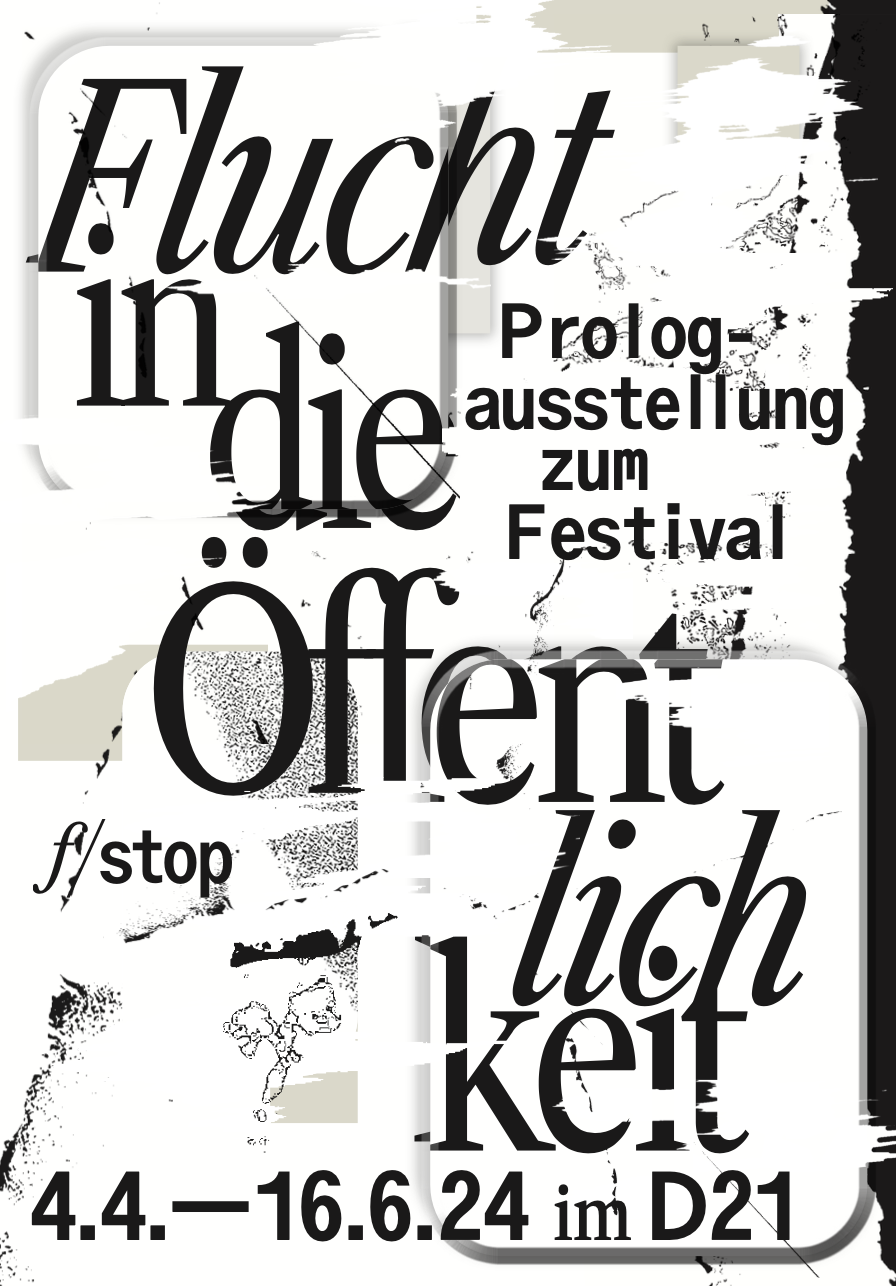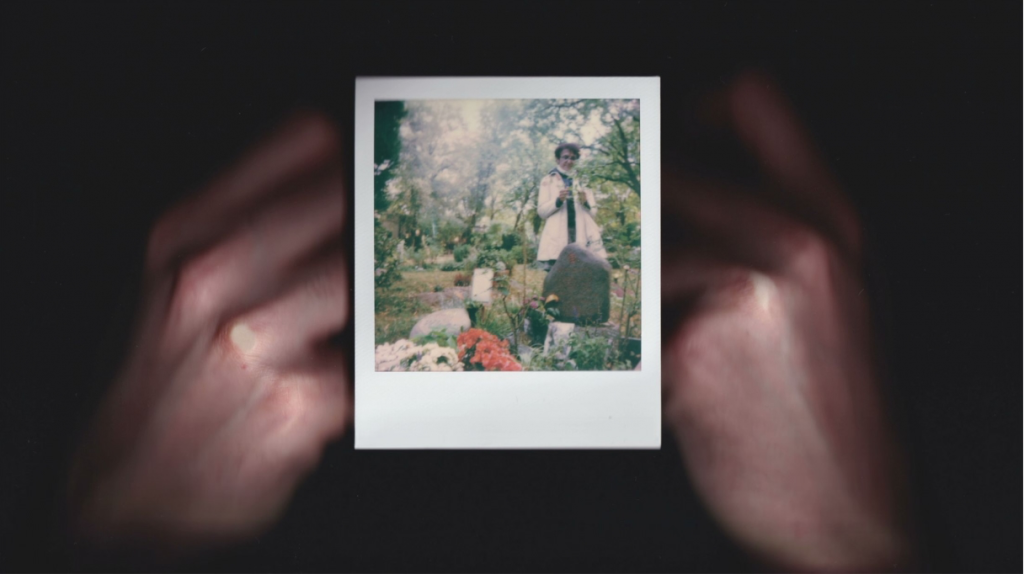Flucht in die Öffentlichkeit
The prologue exhibition to the 10th f/stop — Festival for Photography Leipzig at Kunstraum D21 primarily brings together historical artistic practices that use the camera as a means of subliminal resistance and utilise the photographic and filmic image to create communities. The works from the 1970s to the present day create (counter)publics and subvert representational norms. They form reference points for the f/stop festival course, which opens on 31 May 2024.
The exhibition title Flucht in die Öffentlichkeit (escape into the public sphere) refers to an artistic strategy, which both Gabriele Stötzer and the Künstlerinnengruppe Erfurt used to counter the continuous decomposition (Zersetzung) of critical communities by the Stasi in the 1980s. Instead of limiting themselves to working in secret, exhibitions and events were advertised and organized in public, so that state repression was exposed just as much as the art itself. From a state perspective, the association of people of similar convictions was perceived as a threat—which confirmed the feeling that a community had more freedom of action than the sum of its individuals.
Following the group of artists and Gabriele Stötzer’s practice, “Flucht in die Öffentlichkeit—Festival Prologue” relates moments in which artistic actions use the camera to unfold an emancipatory potential and develop specific forms of publicity. Social inter-actions and forms of solidarity play just as important a part as the artistic result itself, even if they mostly take place outside the images. With a focus on the 1970s and 1980s, the exhibition focuses on a period in which photography and film were closely interwoven with actionist art, which attempted to locate the human (and collective) body in its social context, to break with body norms and to open up spaces for divergence. The exhibition focuses on political power structures and situations in which these become fragile.
How do you demonstrate resistance during a staged public assembly? Ion Grigorescu secretly documented a strictly orchestrated election rally during the Ceaușescu regime in Romania. An involuntary participant in the event, he held his camera at waist height to capture what could not be seen from the outside: secret service agents supervising the assembly, and minimal gestures of protest, such as signs held upside-down or participants taking a break under some trees. Grigorescu used a hidden camera to look behind the public façade of a political staging and to visualize its ambivalences.
Sanja Iveković performs an almost opposite movement by deliberately disrupting a political staging in her famous work “Triangle”. In her performance, documented in photography and writing, she defies a ban on opening windows and using balconies in a block of flats during Tito’s 1979 parade in Zagreb. By seemingly masturbating on the balcony while reading Tom Bottomore’s “Elites and Society”, Iveković not only violated the official orders, but also confronted the prescribed uniformity with an exercise of physical and intellectual self-determination. A few years later, British photographer Jo Spence, together with her partner Terry Dennett, began working on her series “Remodelling Photo History,” which breaks with the ways in which the female nude is generally portrayed in photography. The subjects in this series are staged and yet closer to reality than those in many male photographers’ works. With her “Photo Therapy” series, Spence, in collaboration with Rosy Martin, addresses the medium of the family album, whose role and image types she subverts through psychoanalytically inspired stagings.
Martha Rosler also worked on gendered role models in her early video work “Backyard Economy” which portrays the labor carried out behind closed doors. In disquietingly aestheticized imagery, freshly laundered sheets wave in the backyard as a symbol of reproductive work that remains unpaid and invisible as the basis of our society. Shooting with silent Super‑8 mm film, the ultimate home movie format of the era, she produces the image of a private and every-day scene that was to become a public symbol.
The Künstlerinnengruppe Erfurt also looked for ways to deconstruct oppressive and stereo-typical role models—it is no coincidence that their first joint work is a cinematic adaptation of their “women’s dreams.” Annual film projects formed a continuity in the group’s collaboration. The artists often staged themselves in elaborate and allusive costumes and use rooftops, backyards and the street as a backdrop and counterpart to their humorous and grotesque scenes. Gabriele Stötzer was a driving force of the group, which was active from 1984 to 1994. Her photographs also focus on female expression and physicality. Time and again, people from her circle of friends—artists, punks, writers, musicians —became her subjects during joint activities, parties and events and are thus representative of a time when friendly alliances and gatherings had a political dimension and many times lead to direct consequences.
The clash between intimacy and state surveillance is also explored by Zbigniew Libera. In his photographs, the artist shows a highly contradictory moment. Surrounded by enormous walls and fences, a group of half-naked men sit in the sun on a narrow strip of grass. What is confusing about this scene is not only the prison architecture and the men’s apparently relaxed mood, but also the nature of the shots: slightly out of focus and taken from strange perspectives, they look like awkward snapshots. Libera, too, had to take these pictures secretly. As a consequence of his leaflet campaigns in support of the Polish Solidarity movement (Solidarność), he was arrested in 1982 and, after a few months in solitary confinement, was transferred to a prison for political prisoners where conditions were comparatively comfortable. The prison yard served as a meeting place for a number of intellectuals, opposition activists and artists, where, it seems, sunbathing became a gesture of political resistance.
“ziyaret, visit” by Aykan Safoğlu is a portrait of the Old St Matthew’s Churchyard in Berlin and the actions of activist Gülşen Aktaş, who is devoting herself to tending the graves of care workers, activists and cultural workers who were committed to fighting sexual and racial discrimination and advocating for migrant, queer and feminist causes.
The artists and stories featured in “Flucht in die Öffentlichkeit—Festival Prologue” share a desire to express their view of society and their artistic convictions at a time when their voices were un- heard or even banned. From different perspectives, their works describe how art has the ability to create different forms of publicity and develop a perception of which allow groups to maintain their critical and resistant momentum.
Many thanks to the lenders of the exhibition: Kontakt Sammlung, Vienna; Galerie Loock, Berlin; Richard Saltoun, London; Electronic Arts Intermix (EAI), New York and to all the artists.






